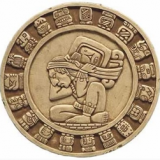Indian Gemstone Jewelry Using Vedic Astrology: Remedy for Ketu
Gemstones and jewelry based on Vedic Indian astrology system can influence the effects of Ketu, one of the “planets” unique to Vedic astrology. However, Ketu is really not a planet. If you think about the course the Sun and the Moon make in a given day around the Earth then Ketu is one of those points when they are in exact alignment with Rahu being the other point. These points are called “nodes” and the path is called the ecliptic. Vedic astrologers ascribe special power to these points and in many cases their effects are stronger than the traditional planets.
Ketu is considered to be the tail of the snake (the descending node) whereas Rahu is the head. The ecliptic has been referred to as a “snake” which encircles the Earth since ancient times both in India and elsewhere. The rest of this article will describe this particular point in the ecliptic and the influence a proper gem remedy can have on it.
KETU
Ketu is the descending node of the moon through the eyes of Indian Astrology. Ketu is known to afflict the Sun more so than any other planet. This is in contrast to Rahu, which is associated with the Moon.
Ketu is also associated with comets and like its associate Rahu it is known to be exceedingly cruel and malefic. Though interpreting Ketu is somewhat difficult the basic theme seems to be release and transformation. More specifically Ketu points to the past life karma of an individual through its placement in the chart.
Ketu brings about spiritual enlightenment. Unfortunately it does through the placement of problems, pain and roadblocks, which are meant to help us in our spiritual growth. Ketu has a tendency to behave like Mars and as a result fire and accidents are also associated with Ketu.
Special note should be made of the Ketu dasha cycle. The dasha of Ketu lasts seven years and it is common knowledge in Vedic astrology that Ketu always has a “sting” in its tail. This means that somehow the end of a Ketu dasha cycle will be potentially problematic or troublesome. It may help to use a gemstone remedy during this time period.
Ketu and Rahu have the same affiliations for animals which are the following: snakes, camels, the ass, wolves, rodents, mosquitoes, scorpions and any other animal that utilizes poison in its defense. No food is associated with Ketu or Rahu.
Ketu is especially affiliated with the owl.
NAMES:
Ketu, Sikhin, Dhvaja, Dhum, Mrityu Putr and Anala. The common term is Ketu.
ATTRIBUTES:
In Indian Astrology Ketu is associated with broken relationships, changing events and accidents. Electronics have also been placed under his influence in the modern era.
Other noted areas under his influence are ascetics, renunciation, assassinations, cats, clairvoyance, contemplation, desire for knowledge, deep thinking, imprisonment (like Saturn), poison, intrigues, magical powers, poverty and mysticism.
ASSOCIATIONS:
Ketu is associated with the god Brahma in many places. Another popular affiliation is Ganesha, which seems more intuitive considering he is known as the “remover of obstacles”.
Ketu has an unusual association in terms of direction. He is most often noted to be the “center” which is really no direction at all.
The story of Rahu and Ketu is integral to the conflict between the Devas and the Asuras. Legend says that long ago when the Devas and Asuras joined to churn the milk of the cosmos it was a serpent named Vasuki, which was used as the spindle. Vasuki was a naga and the ruler of Patala Loka, which was associated with the nether regions of Earth. After the churning took place a conflict arose and Vishnu cut Vasuki in half, but not before the demon had drank the nectar of immortality. Thus, Vasuki then split into two immortal parts, which are now known as Rahu, his severed head and Ketu, his tail.
Ketu is associated with the 48th year of life.
Ketu has no sign, which it rules but it is considered exalted in Scorpio and fallen in Taurus.
Ketu is extremely malefic though the affliction it gives brings about enlightenment and spiritual growth.
Ketu has special affiliation with the Nakshatra Abhijit.
Ketu is variegated in color and associated with the metal Lead. Turquoise is associated with him in addition to his normal gemstone, which is discussed below.
Earth is considered the element of Ketu.
Ayurvedic medicine ascribes a Vatta constitution to Ketu.
AREAS OF EFFECT TO LOOK FOR CHANGES
Renunciation, enlightenment, spiritual authority, ascetics, clairvoyance, dissatisfactions, separations, breaks, helplessness, negative habits, liberation, artistic tastes, bankruptcy, sudden windfalls, lower classes of society, things strange or foreign, cheating, cataclysm, comets, smoking, philosophers, assassins, mental illness.
NOTES ON USING JEWELRY AND GEMSTONES BASED ON VEDIC ASTROLOGY TO INFLUENCE KETU
A gem remedy of Ketu can be especially helpful during the time of his dasha, which can be troublesome, especially toward the end.
Cat’s Eye Chrysoberyl is most often associated with Ketu. There is a strong case for Turquoise being just as powerful in terms of a remedy. Lead is considered the metal of choice but most find it unattractive and impractical for a setting. Other alternatives are silver or brass.
A Vedic Ketu gemstone and jewelry remedy can influence the following areas: tendency toward accidents, anger, irritability, impatience, inconstancy, eccentricity, fanaticism, explosiveness, violence, oddity, amorality, impulsiveness, emotional tension and mental problems.






